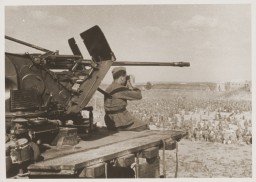You searched for: 澳门太阳城注册【手动输入∶___bet163.net___】最新地址请收藏,澳门太阳城注册送14,澳门太阳城注册送18,澳门太阳城注册送27,澳门太阳城注册送28,澳门太阳城注册送38,澳门太阳城注册送88,澳门太阳城注册送118。
<< Previous | Displaying results 176-200 of 748 for "澳门太阳城注册【手动输入∶___bet163.net___】最新地址请收藏,澳门太阳城注册送14,澳门太阳城注册送18,澳门太阳城注册送27,澳门太阳城注册送28,澳门太阳城注册送38,澳门太阳城注册送88,澳门太阳城注册送118。" | Next >>
-
Fischel (Philip) Goldstein
ID CardFischel was the youngest of five children. He came from a Jewish family of artisans; his father was a tailor, his uncles were furriers, and his sister was a dressmaker. Fischel started his education at a Jewish parochial school at age 3, where he studied Hebrew and Yiddish. He continued his education at Jewish private schools until age 10, when he entered Polish public schools. 1933-39: After graduating from the Polish public school system at age 14, Fischel started an apprenticeship in his father's…

-
Itka Wlos
ID CardItka was raised in a Yiddish-speaking, religious Jewish family in Sokolow Podlaski, a manufacturing town in central Poland with a large Jewish population of about 5,000. Itka came from a poor family. After completing her public schooling in Sokolow Podlaski at the age of 14, she began to work. 1933-39: Itka was a young woman, unmarried and living with her parents when war between Germany and Poland broke out on September 1, 1939. German aircraft bombed Sokolow Podlaski's market and other civilian targets…

-
Elka Rosenstein
ID CardElka was raised in a large, Yiddish-speaking Jewish family in Sokolow Podlaski, a manufacturing town in central Poland with a large Jewish population of some 5,000. Elka was 14 when she graduated from middle school. After completing her schooling, she became a tailor. Working at home, she made clothes for different clothiers in town. 1933-39: Elka was unmarried and living with her parents when war between Germany and Poland broke out on September 1, 1939. German aircraft bombed Sokolow Podlaski's market…
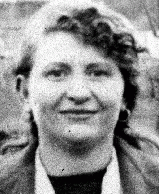
-
Sarah Rivka Felman
ID CardOne of seven children, Sarah was raised in a Yiddish-speaking, religious Jewish home in Sokolow Podlaski, a manufacturing town in central Poland with a large Jewish population of some 5,000. Sarah's parents ran a grain business. In 1930, Sarah began attending public elementary school in Sokolow Podlaski. 1933-39: After graduating from middle school in 1937 at the age of 14, Sarah helped out her now widowed mother in the family's grain business. Two years later, Germany attacked Poland. German aircraft…
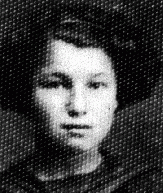
-
Chinka Schwarzbard Felman
ID CardOne of six children, Chinka was raised in a Yiddish-speaking, religious Jewish family in the town of Ostrow Mazowiecka, where her father was a wine maker. In 1910 she married Ephraim Isaac Felman, and a few years later the couple moved to Sokolow Podlaski, where Chinka helped her husband run a grain business. The Felmans had seven children, two of whom died in infancy. 1933-39: Chinka's husband died in 1935, and she took over the grain business with the help of her children. That same year, her oldest…

-
Brandenburg T4 Facility
ArticleBrandenburg was one of six killing centers the Nazis established to murder patients with disabilities under the so-called "euthanasia" program.
-
Gleichschaltung: Coordinating the Nazi State
ArticleGleichschaltung is the German term applied to the Nazification of all aspects of German society following the Nazi rise to power in 1933.
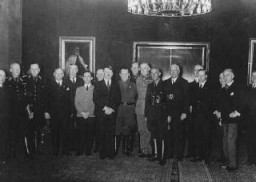
-
Sobibor - Maps
Media EssayThe Sobibor killing center in German-occupied Poland was one of four camps linked to Operation Reinhard. On October 14, 1943, Jewish prisoners in the camp launched an uprising. After the revolt, Sobibor was dismantled. At least 170,000 people were...
-
US troops at Gardelegen
PhotoUS troops with the 102nd Infantry Division at a barn outside Gardelegen, where over 1,000 prisoners were burned alive by the SS. Germany, April 14, 1945.
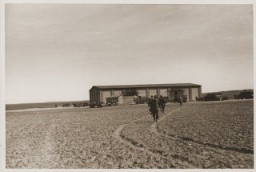
-
Mass grave at Nordhausen
PhotoAmerican soldiers walk along an open mass grave for the of victims of the Nordhausen concentration camp. US army officers ordered the residents of Nordhauen to prepare the grave for the burial of the victims. Nordhausen, Germany, April 13–14, 1945.

-
Simone Schloss
PhotoSimone Schloss, a Jewish member of the French resistance, under guard after a German military tribunal in Paris sentenced her to death. She was executed on July 2, 1942. Paris, France, April 14, 1942.
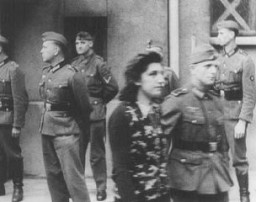
-
Aerial photograph of Auschwitz III
PhotoAerial photograph of the Auschwitz III (Monowitz) camp, which was adjacent to the I.G. Farben plant. The photograph was taken following US bombing missions. Poland, January 14, 1945.
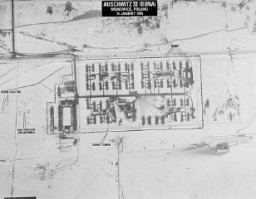
-
Roundup in Paris
PhotoAfter the first roundup in Paris, French police escort foreign Jewish men from the Japy school to deportation trains at the Austerlitz station. Paris, France, May 14, 1941.
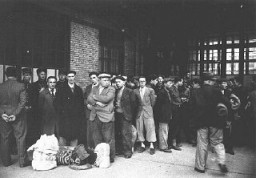
-
Austrian refugees arrive in Shanghai
PhotoAfter the Anschluss (German annexation of Austria), Austrian Jewish refugees disembark from the Italian steamship Conte Verde. Shanghai, China, December 14, 1938.
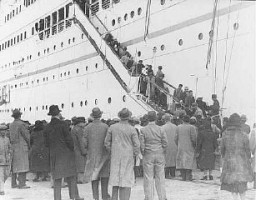
-
Burial of victims of the Dora-Mittelbau camp
PhotoAfter the liberation of Dora-Mittelbau, local German residents were required to bury the bodies of victims of the camp. Dora-Mittelbau, Germany, April 13–14, 1945.
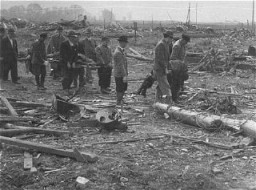
-
Bodies of prisoners killed in the Nordhausen camp
PhotoThe bodies of prisoners killed in the Nordhausen concentration camp lie in a mass grave dug by German civilians under orders from US troops. Nordhausen, Germany, April 13-14, 1945.
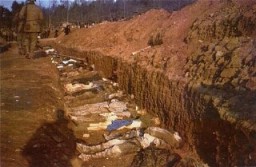
-
Bergen-Belsen displaced persons camp
PhotoThe American Jewish Joint Distribution Committee pharmacy in the displaced persons camp at Bergen-Belsen. Germany, August 14, 1947.

-
German soldier guarding Soviet prisoners of war
PhotoA German soldier guards Soviet prisoners of war at the Uman camp in the Ukraine. Soviet Union, August 14, 1941.

-
US Marines on Peleliu Island
PhotoUS Marines during the final stage of the fight for Peleliu Island in the Pacific theater of war. September 14, 1944.
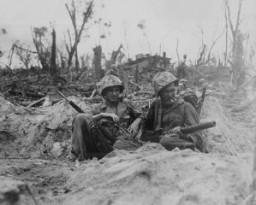
-
Waitstill and Martha Sharp supervise the arrival of milk products
PhotoWaitstill and Martha Sharp supervise the arrival of 14 tons of milk products to distribute to children in the region. Pau, France, August 1940.
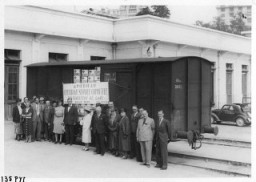
-
The 102nd Infantry Division
ArticleOn April 14, 1945, the US 102nd Infantry Division uncovered the site of a hideous massacre of concentration camp prisoners outside the town of Gardelegen.

-
1946–1948: Key Dates
ArticleExplore a timeline of key events during 1946-1948. Learn about the aftermath of the Holocaust and the obstacles survivors faced.
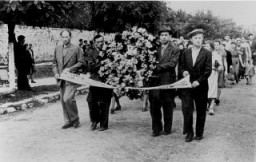
-
Louis Fischer
ArticleLouis Fischer was an American political historian. In May 1933, his work was burned in Nazi Germany for its sympathy toward Communism. Learn more.
-
Diploma certifying vocational training issued to a DP
PhotoDiploma issued by the International Refugee Organization (IRO) certifying that Naftali Froimowicz was trained as a shoemaker in Turin, Italy on November 14, 1949. Froimowicz lived in several displaced persons (DP) camps in Italy after the war.
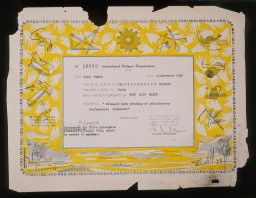
-
German treatment of Soviet POWs
PhotoA German guard sitting on the end of a 20mm gun platform watches over 50,000 Soviet Prisoners of War (POWs) at Stalag 349, Ukraine, August 14, 1941.
